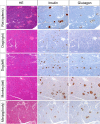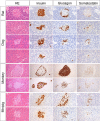A comparison of the anatomical structure of the pancreas in experimental animals
- PMID: 27559239
- PMCID: PMC4963614
- DOI: 10.1293/tox.2016-0016
A comparison of the anatomical structure of the pancreas in experimental animals
Abstract
As basic knowledge for evaluation of pancreatic toxicity, anatomical structures were compared among experimental animal species, including rats, dogs, monkeys, and minipigs. In terms of gross anatomy, the pancreases of dogs, monkeys, and minipigs are compact and similar to that of humans. The rat pancreas is relatively compact at the splenic segment, but the duodenal segment is dispersed within the mesentery. In terms of histology, the islet of each animal is characterized by a topographic distribution pattern of α- versus β-cells. β-cells occupy the large central part of the rat islet, and α-cells are located in the periphery and occasionally exhibit cuffing. In dog islets, β-cells are distributed in all parts and α-cells are scattered in the center or periphery of the islet (at body and left lobe); whereas β-cells occupy all parts of the islet and no α-cells are present in the islet (at right lobe). Monkey islets show two distinct patterns, that is, α-cell-rich or β-cell-rich islets, and the former represent peripheral β-cells forming an irregular ring. Minipig islets show an irregular outline, and both α- and β-cells are present in all parts of the islet, intermingling with each other. According to morphometry, the endocrine tissue accounts for <2% of the pancreas roughly in rats and minipigs, and that of monkeys accounts for >7% of the pancreas (at tail). The endocrine tissue proportion tends to increase as the position changes from right to left in the pancreas in each species.
Keywords: endocrine-exocrine interface; extra-insular endocrine cell; pancreas; peri-islet; α-cell; β-cell.
Figures





Similar articles
-
Immunohistochemical studies on the splenic lobe of the pancreas in young Japanese quails (Coturnix c. japonica).Dtsch Tierarztl Wochenschr. 2008 May;115(5):189-93. Dtsch Tierarztl Wochenschr. 2008. PMID: 18547019
-
Duct- to islet-cell differentiation and islet growth in the pancreas of duct-ligated adult rats.Diabetologia. 1995 Dec;38(12):1405-11. doi: 10.1007/BF00400600. Diabetologia. 1995. PMID: 8786013
-
Comparative analysis of insulo-acinar portal system in rats, guinea pigs, and dogs.Microsc Res Tech. 1997 Jun 1-15;37(5-6):489-96. doi: 10.1002/(SICI)1097-0029(19970601)37:5/6<489::AID-JEMT11>3.0.CO;2-M. Microsc Res Tech. 1997. PMID: 9220426
-
Multipotential nestin-positive stem cells isolated from adult pancreatic islets differentiate ex vivo into pancreatic endocrine, exocrine, and hepatic phenotypes.Diabetes. 2001 Mar;50(3):521-33. doi: 10.2337/diabetes.50.3.521. Diabetes. 2001. PMID: 11246871
-
Distinct function of the head region of human pancreas in the pathogenesis of diabetes.Islets. 2013 Sep-Dec;5(5):226-8. doi: 10.4161/isl.26432. Epub 2013 Sep 17. Islets. 2013. PMID: 24045229 Free PMC article. Review.
Cited by
-
International Harmonization of Nomenclature and Diagnostic Criteria (INHAND): Non-proliferative and Proliferative Lesions of the Non-human Primate (M. fascicularis).J Toxicol Pathol. 2021;34(3 Suppl):1S-182S. doi: 10.1293/tox.34.1S. Epub 2021 Sep 28. J Toxicol Pathol. 2021. PMID: 34712008 Free PMC article. Review.
-
A 90 day oral toxicity study of blueberry polyphenols in ovariectomized sprague-dawley rats.Food Chem Toxicol. 2020 May;139:111254. doi: 10.1016/j.fct.2020.111254. Epub 2020 Mar 9. Food Chem Toxicol. 2020. PMID: 32165232 Free PMC article.
-
Reproducible insulin secretion from isolated rat pancreas preparations using an organ bath.Exp Anim. 2018 Feb 9;67(1):15-22. doi: 10.1538/expanim.17-0059. Epub 2017 Jul 28. Exp Anim. 2018. PMID: 28757517 Free PMC article.
-
Comparative study of pancreatic vessels and mesopancreas of rhesus monkeys and humans.Front Surg. 2023 Jun 2;10:1112316. doi: 10.3389/fsurg.2023.1112316. eCollection 2023. Front Surg. 2023. PMID: 37334206 Free PMC article.
-
Dynamics of total volume of pancreatic α- and β -cells under the influence sulfonylureas and their combination with dipeptidyl peptidase-4 inhibitors.Endocrinol Diabetes Metab. 2021 Mar 18;4(3):e00238. doi: 10.1002/edm2.238. eCollection 2021 Jul. Endocrinol Diabetes Metab. 2021. PMID: 34277963 Free PMC article.
References
-
- Greaves P. Liver and Pancreas. Endocrine Pancreas. In: Histopathology of Preclinical Toxicity Studies: Interpretation and Relevance in Drug Safety Evaluation, 4th ed. P Greaves (ed). Academic Press, Amsterdam. 501–510. 2012.
-
- Kierszenbaum AL. Endocrine System. In: Histology and Cell Biology: An Introduction to Pathology, 2nd ed. AL Kierszenbaum (ed). Mosby Elsevier, Philadelphia. 537–567. 2007.
-
- Kierszenbaum AL. Digestive Glands. In: Histology and Cell Biology: An Introduction to Pathology, 2nd ed. AL Kierszenbaum (ed). Mosby Elsevier, Philadelphia. 485–513. 2007.
-
- Cattley RC, Popp JA, and Vonderfecht SL. Liver, Gallbladder, and Exocrine Pancreas. Exocrine Pancreas. In: Toxicologic Pathology: Nonclinical Safety Assessment. PS Sahota, JA Popp, JF Hardisty, and C Gopinath (eds). CRC Press, Boca Raton. 345–356. 2013.
-
- Kui B, Balla Z, Végh ET, Pallagi P, Venglovecz V, Iványi B, Takács T, Hegyi P, and Rakonczay Z., Jr Recent advances in the investigation of pancreatic inflammation induced by large doses of basic amino acids in rodents. Lab Invest. 94: 138–149. 2014. - PubMed
Publication types
LinkOut - more resources
Full Text Sources
Other Literature Sources
Research Materials
